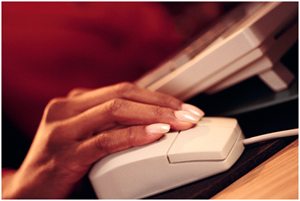Treating Anxiety with the Click of a Mouse
An SDSU psychology professor developed a computer program as an alternative to therapy and medication.

Social anxiety disorder, the most common anxiety disorder in the country, is often treated with medication or cognitive behavior therapy. But if medication doesn’t work, and therapy is too expensive, what other option is there?
San Diego State psychology professor Nader Amir has come up with a new, third approach: a simple computer program. Played for only 10–15 minutes twice a week for four weeks, it helps shift a person’s attention from negative thinking, which eases anxiety symptoms.
As effective as traditional methods
“It sounds too simple to be true,” Amir said. But after four years of testing at SDSU, in England and in Australia, research results indicate the approach works as well as medication or talk therapy.
“We have about 20 years of research showing that anxious people focus on the negative, so we know attention is a big factor,” he said. “You can actually change this, as we try to do in therapy or with medication, but the notion that a computer program can change attentional bias is relatively new.”
Retraining through repetition
The first of its kind, the simple program is designed to change that bias and retrain people through the repetition of a basic task. Amir compares these tasks to brushing your teeth—a repetitive, often boring task—but one that’s good for you and will help you in the long run.
Pictures of faces show up two at a time, and as they fade away, a letter shows up in the place of one of the faces. The individual is then asked to decide whether the letter was an “E” or and “F” by pressing a corresponding mouse button. Those who have problems with anxiety tend to focus on the negative face and hence are faster to make a decision about the letter when it follows a negative face, compared to when it follows a neutral face.
Through repetition, the program retrains people to look at both faces equally in order to get the correct response.
The program is ideal for people who recognize their anxiety symptoms, but don’t know why they have them or how to fix them. It is also in demand by hospitals and insurance companies who want clients to try the program before therapy sessions.
Making treatment more accessible
The subjects Amir tested for his study had dealt with anxiety problems for an average of 11 years. This isn’t surprising as a recent study showed that 95 percent of people who want therapy don’t get it because of the time, distance or cost issues.
“The bottom line issue is cost—we’re talking hundreds and hundreds of dollars. One session of cognitive therapy is around $100. But what we’re more excited about is access. People have computers at home, and can easily use this program.”
Different models of the program are available for purchase for $139.99, and can be downloaded online at www.managingyouranxiety.com.



